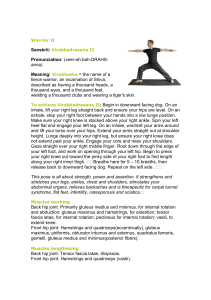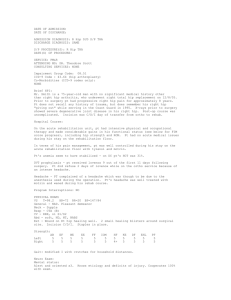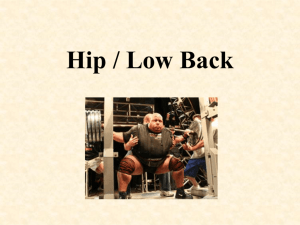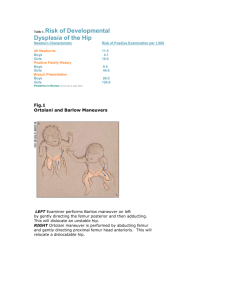Muscles of the Hip
advertisement
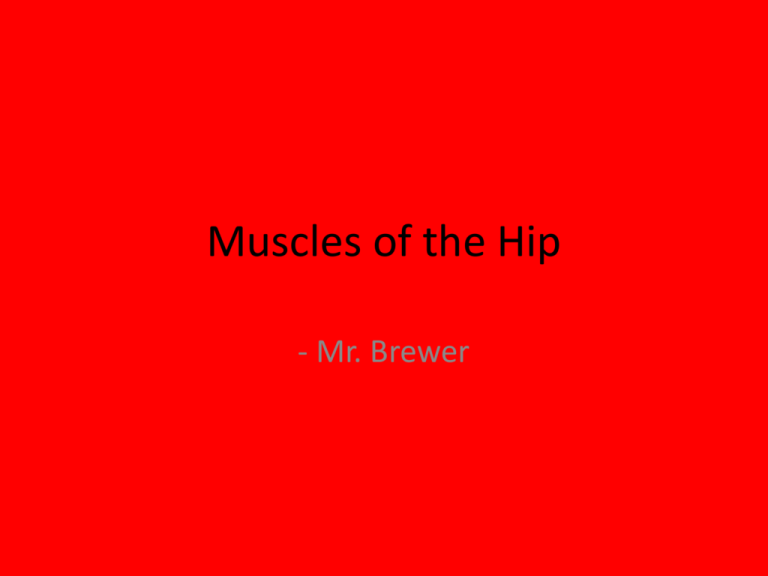
Muscles of the Hip - Mr. Brewer Hip Movements Video https://www.youtube.com/watch?v=qlCvKEOZtp o - Intro Video that explains some muscles of the hip and the actions they create. - Start at ~4:30. Actions - Hip Flexion – (5) - Rectus Femoris Psoas (Major and Minor combined) Iliacus Pectineus Sartorious - Hip Extension – (4) - Gluteus Maximus Biceps Femoris Semitendinosous Semimembranosous - Hip Adduction – (4) - Adductor Magnus Adductor Longus Adductor Brevis Gracilis - Hip Abduction – (2) - Gluteus Medius Tensor Fascia Latae (TFL) - Inward Rotation – (1) - Gluteus Minimus - Outward Rotation – - Six Outward Rotators (1 group of 6 muscles) Hip Flexion Which of these pictures represents hip flexion that involves all 4 quadricep muscles? Why? Hip Flexion - Rectus Femoris – The only muscle in the quadriceps group that crosses the hip joint. - Attaches proximally to the AIIS of the pelvis. Hip Flexion Iliopsoas: - The Iliopsoas is a common term used for the Psoas and Iliacus muscles in combination. - They have different originations, but join together and insert distally at the lesser trochanter of the femur. * Psoas - Broken down into the Psoas Major and Psoas Minor muscles. - Attach proximally to the LUMBAR vertebrae. (Origin) • Iliacus – - Covers the inside of the Ilium and attaches along the Iliac Crest. Hip Flexion - Pectineus – The pectineus muscle is primarily responsible for flexion of the femur at the hip. - Because of it’s location, the pectineus also assists in hip adduction. Hip Extension Both are considered to be “Hip Extension” exercises, but which of the following hip extension exercises involves the hamstrings more? Why? Hip Extension Hamstrings: Biceps Femoris: - Lateral hamstring muscle Semitendinosus and Semimembranosus: - The Medial hamstring muscles * All 3 of the Hamstring muscles attach proximally to the ISCHIAL TUBEROSITY. Hip Extension - Gluteus Maximus - Primary function is Hip Extension. - With Knee bent, Hip Flexion relies on the Glute Max more- so than with the leg fully extended at the knee. - Distal insertion includes joining to the IT Band. Hip ABduction Hip ABduction - Hip Abduction uses the muscles on the lateral aspect of the thigh and hip to move the femur from the midline of the body, laterally to the outside. - http://www.mayoclinic.org/healthyliving/fitness/multimedia/standing-hipabduction/vid-20084670# Hip ABduction • Gluteus Medius – • The gluteus medius muscle is a small muscle that lies directly underneath the Gluteus Maximus. • The location on the lateral hip gives the Gluteus Medius a larger role in hip Abduction than the Gluteus Maximus which primarily is responsible for Hip Extension. Hip ABduction Tensor Fasciae Latae: - The “TFL” for short. - The distal end of the TFL becomes the iliotibial band (IT Band) - Shares the IT Band with the Gluteus Maximus. Hip ADDuction Hip ADDuction – bringing the femur back to the mid-line of the body. - Primarily uses adductor muscles that some people refer to as the “groin” muscles, located on the inside(medial) portion of the thigh. - Which exercise shown to the right involves the Gracilis more? Why? Hip ADDuction • Gracilis: – The Gracilis is the longest of the adductor muscles. – The only adductor muscle to also cross the knee joint for additional stability. – Same reason as to why the Gracilis is more active with Hip Adduction that takes place while the knee is at or below 0 degrees. (Full Extension or Hyperextension) Hip ADDuction • Adductor Longus and Adductor Brevis: – *Both the Longus and Brevis muscles attach proximally to the pubis bone. – The longus is a little longer, and also forms the medial border of the femoral triangle. • Adductor Magnus: – The largest and deepest of the adductor muscles. – Very large muscle that covers most of the medial aspect of the thigh. – Forms what is called the “adductor hiatus” Adductor Hiatus Femoral Triangle The Femoral Triangle is a space that is formed by the borders of the different muscles and a ligament. This “Triangle” is space for nerves and blood vessels to travel. - Gracilis– Medially - Sartorius – Laterally - Inguinal Ligament – Superiorly Medial(Internal) or Lateral(External) Rotation? 1 2 Medial Rotation 3 Lateral Rotation Medial Rotation Inward Rotation and Outward Roation • A.K.A. Medial and External rotation of the femur. • https://www.youtube .com/watch?v=vItv4L 2ktYI – Knee in Full Extension • https://www.youtube .com/watch?v=bZAFe mNhiVk – Bent Knee (Sitting and Supine) Medial (Inward) Rotation • Gluteus Minimus: – The smallest of the gluteal muscles. – Connects from the Ilium along the gluteal line and wraps around to connect to the greater trochanter of the femur. – Active use of this muscles will cause the femur to rotate medially. External (Outward) Rotation Gluteus Medius and Minimus https://www.youtube.com/watch?v=0CEeHPpY MfM – Video shows layer by layer view of gluteal muscles of the hip. - Also illustrates movements that they are involved in creating at the hip. - ** The Gluteus MINIMUS is responsible mainly for medial rotation.**
